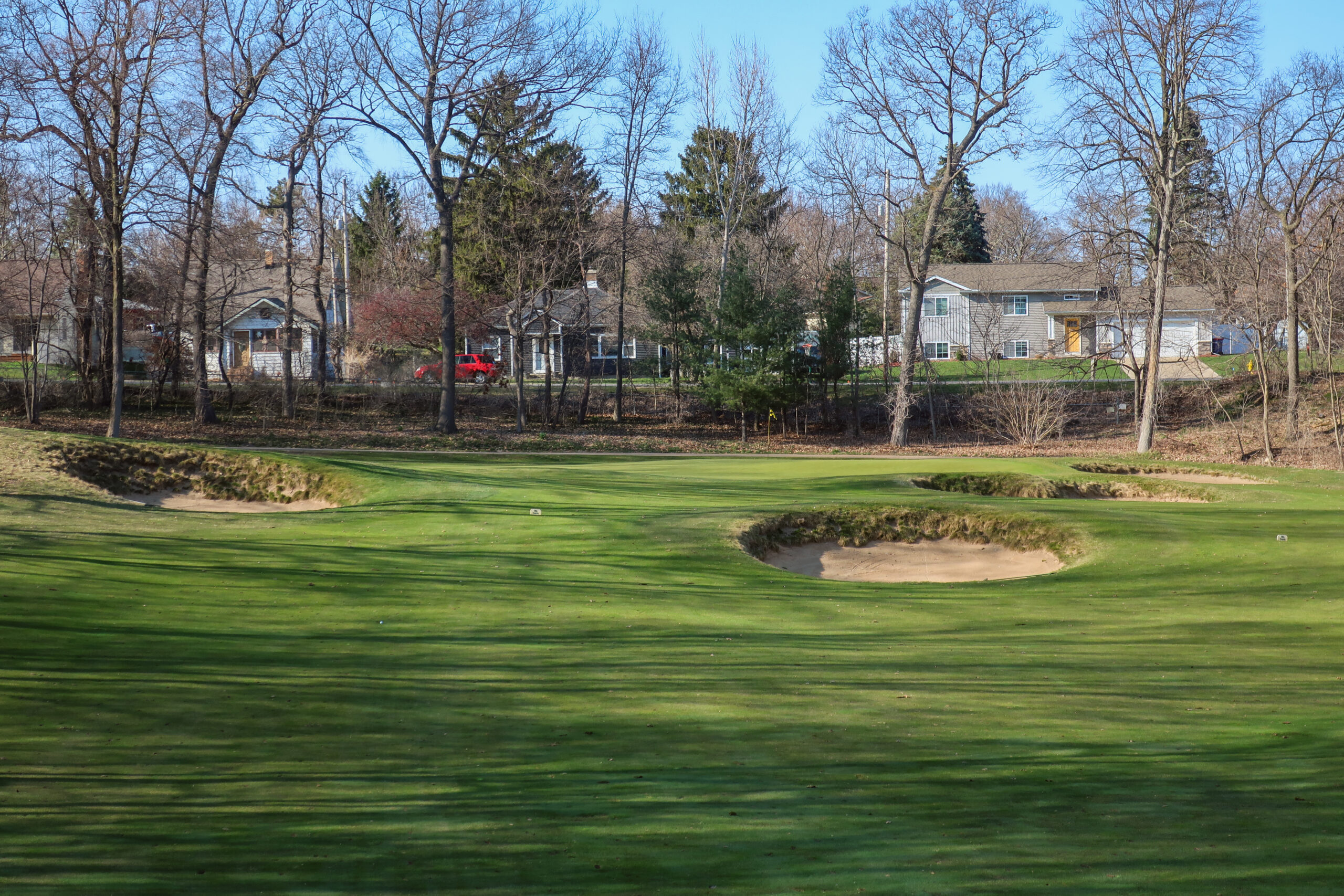Growing up, The Masters is the unofficial start to golf season. Long winters of cloud cover and the sounds of the front edge of a shovel shovelling snow off the ground are replaced with blooming azaleas, fake birds chirping on CBS, and the sights of the shockingly green grass of Augusta’s overseeded Rye, a colour not seen since October at least. If Jingle Bells marks the Christmas season, Golden Bell rings in spring for golfers in the north.
Such is the case this year; no different than growing up as a kid, still eager to get out and play golf. I still have that giddiness to get out in April, not lost on me yet as others have told me comes eventually. Rather than Land-O-Lakes or Evergreen Golf Centre in Southern Alberta, I would rather take the time to seek out architecturally interesting public golf, even if it requires a bit of a drive from Toronto. Usually, this is Tarandowah, about 90 minutes from Toronto International Airport (YYZ) near London. It opens earlier than other courses given its stylistic choice of less trees on the windswept faux-links in the farmland of southern Ontario. I already went to Tarandowah, which led me to search for other options.

Masters Week 2023 took me to Grand Rapids, Michigan. For some reason, I woke up with an interest to play my first Mike DeVries design, perhaps credited to a discussion with a group of friends who mentioned DeVries would be the next name they would want to see under the Cabot/Bandon/Dream Golf portfolio get a big gig now that Whitman, Axland, and Cutten are firmly in the mix with Revelstoke and Bandon. In April, the options are limited for DeVries, who reminds me of Whitman’s career until recent (even up to the merger of Clayton, DeVries, Pont happened in a similar timeline of Whitman, Axland, Cutten). In my mind, Cape Wickham is DeVries version of Cabot Links, although I might venture twice (triple?) as difficult to get to from where I live. After that, a handful of local favourites in Michigan: Kingsley Club is the private juggernaut in the state (Blackhawk), though I have not played it yet. Greywalls especially, with the supporting cast of Pilgrim’s Run, Diamond Springs, and The Mines provide numerous options for public golfers in Michigan to experience his architecture (Sagebrush, Wolf Creek x2). I wanted to go, but Greywalls, Kingsley Club, Pilgrim’s Run, and Diamond Springs were not open. To The Mines it was!
Masters Week is obviously an exciting golf week, but especially for Mackenzie fans, who see one of his three best designs, alongside Cypress Point and Royal Melbourne. Not far behind, though, would be Crystal Downs near Traverse City, Michigan, where DeVries grew up. Crystal Downs is a Mackenzie & Perry Maxwell, the two gentlemen responsible for the first two decades at Augusta National. It laid the groundwork for Tom Doak’s appreciation of Mackenzie’s work, who also lives nearby and Mike DeVries worked under.

To my surprise, The Mines was the perfect course to play on Masters Week. Not because aesthetically it reminded me of Augusta National or anything—Augusta, Georgia is a long way from Grand Rapids, Michigan both physically and in this metaphor—but because, like Tom Doak’s work, it featured the aroma of Mackenzie’s pedigree in the DNA of the golf course.
Perhaps this is a fairly flippant comparison for some, but stay with me and let me explain. The routing is disjointed, with four holes located on the west side of Covell Ave, the latter half of the front nine and the first two of the back nine on its own parcel, and the meat of the back nine on its own section, minus the finishing hole which returns to the 9th, 10th, and the clubhouse. It seemed fairly budget conscious, at least from my perspective (the $70 green fee, including cart mid-summer, seems to confirm my suspicions). Yet, The Good Doctor’s architecture begins to pop up sporadically throughout the property, beginning on the par 4, 2nd. It is an early homage, something that might slip by those not looking hard enough—including me, I only saw it through the lens of the drone post-round. But the green tucked into the hillside, with an attractive bunker scheme, seems like a green complex Alister Mackenzie might find and select.

Even so, a one-off loose correlation doesn’t strike me as enough to claim Mackenzie’s influence on DeVries, let alone The Mines. It seemed far-fetched, even for me. The front nine is mostly solid, quite literally thrusting upon the landscape, mostly filled with up-and-over tee shots on the opening three holes, back-to-back par 3’s (Mackenzie utilized the oddity at Cypress Point), and a solid, if slightly low-key set of two-shot holes. We arrived at the ninth, happy we came even with the notion of lots of golf left to play. The 8th is a true spectacular par 3, a highlight among a good golf course and certainly the most dramatic, photo-op worthy hole on property. After playing this gorgeous one-shot hole, you arrive on the 9th tee, a par 4 running opposite of the long par 5, 5th with a shared fairway.
It is a simple par 4 really, one that plays down off the tee, and back into the hillside at the base of the clubhouse hillside. The 10th hole, up the right, plays high on a plateau, with a dramatic hillside separating the two. It is the green complex, however, that sits into the surroundings effortlessly, that seemed to ring of shades of Meadow Club, a Mike DeVries restoration, or even Crystal Downs. There is no direct template or link back to either club, no copy & paste or anything similar; but the orientation, and particularly the vibe it presented had me thinking of those two courses.

By the 9th, I still felt my comparison was rather… stretched for reasoning. I was happy we came, even if it was much further than we anticipated for a day trip from West Toronto (lol), but I still felt like I was grasping at straws. The 10th, with its nipple in the middle of the green dividing pin locations reminded me of the original 16th green at Augusta National, or should I say, Stoke Park, while the 12th cemented my theory. The bunkering scheme short of the green suddenly had me transported to Northern California, crossing the Golden Gate on the way to Fairfax. Weird, I have not made the journey to Meadow Club yet, but photos from Lukas Michel or The Fried Egg certainly set the table for the comparison.
- Meadow Club (photo credit: PJ Koenig)
- The 12th green at The Mines
If I had any doubts, I was fully ready to write about my theory walking off the 12th green. There was still a third of the golf course left, but I had seen what I needed to: DeVries, like Doak, was heavily influenced by Dr. Alister Mackenzie, and while The Mines might be subtly referencing his body of work, it was obvious in my eyes.
Golf Digest‘s architecture editor Derek Duncan wrote about Augusta National’s three distinct styles of greens: oceanic, stepped, and tilted planes, a few years back. It is an interesting article, diving into the three various styles of greens in how the contours are presented at the world’s most famous golf course. Perhaps a testament to Mackenzie, Maxwell, Cobb, RTJ, Fazio, and more all having a hand in the design of the world’s best tournament venue, but nonetheless, a great article to dive in for Masters week.
I have seen the article before, but I scrolled past it this time. It is a common one for me to see on my feed during early April and alongside the evolution of Augusta National’s article, is among the better things Golf Digest has put out in recent years. This article, though, would spur on a thought in some post-round assessment with friends at a Chic-Fil-A in Lancing, Michigan while forest green spartan shirts surrounded us. I forgot what the three styles of greens were, but I felt like The Mines had three distinct styles, also. There were those of the tiered flavour, perhaps too much for my playing partners. Fair enough, they get old quick, but they contrast nicely with the almost Maxwell-like rolls or ridges on the par 3, 8th or the 2nd, maybe even the 10th. There was less of the tilted plane variety, until we reached the absolutely mind-bendingly good par 4, 14th and short 15th. There was variety, different ways to challenge the golfer and, in my view, a wide range of different levels of challenge. I have only been to Augusta National once, but I felt Derek Duncan’s article was a perfect predecessor for my round at The Mines, which had all three mentioned, but perhaps to a smaller, lesser degree than Augusta National (obviously).

Even with the comparisons between the golf courses, they still are wildly different. Augusta National is among the world’s best golf courses, never ranked worse than 15th on any Top 100 World list. The Mines, however, likely would not crack a top 15 in Michigan list, but that is okay in my mind. It is the perfect Doak 5, a very good local course (and that it is). The Mines is publicly accessible and a bargain, while Augusta National is neither of those things. But the juxtaposition between the two is important, especially around Masters week. Sure, Augusta National might not be a reality to play for most, but architects like Mike DeVries, who are heavily influenced by Dr. Alister Mackenzie, build golf in the spirit of these Golden Age greats.
In this case, The Mines direct homages to Dr. Alister Mackenzie made it a perfect play during the unofficial official start to golf season. Most of Mackenzie’s work hides behind the private gates of swanky, elite golf clubs, but public golf like The Mines, which delivers on a good deal of excellent architecture principles shared between the various levels, is an important way to not only get people interested in golf architecture, but tap into those senses of why you and I enjoy golf architecture. The Masters and Augusta National is one of the world’s most watched events, and while most will never get to play the golf course, they can, and should, seek out golf courses like The Mines in Grand Rapids. Good, accessible golf courses juxtapose against the exclusive private clubs, but when they both play by the same architecture rules and deliver engaging, fun architecture, that is worth applauding.












You have to play Blackhawk in Edmonton. Down along the River. Awesome Course; an outstanding Design by Rod Whitman.
Coming from between Toronto & Hamilton & The Lake sure have had my Eyes opened with Golf Courses in Alberta & B.C.
Especially, WAC Design’s!!!
I was on the 8th that day and heard your drone. Nice write up! The mines is a fantastic gem of west Michigan. Come back anytime!